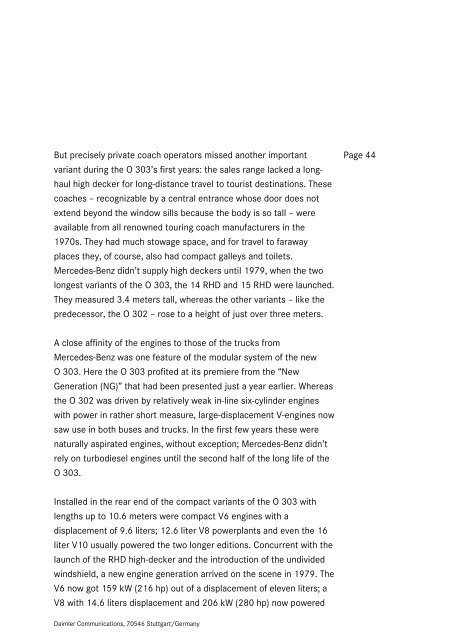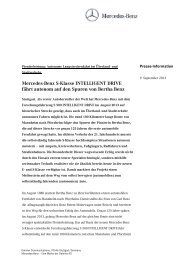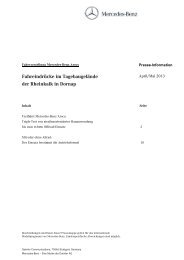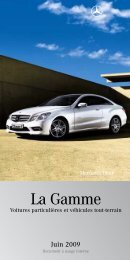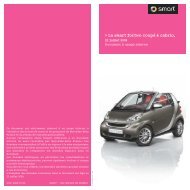Mercedes-Benz Bus History - Daimler
Mercedes-Benz Bus History - Daimler
Mercedes-Benz Bus History - Daimler
You also want an ePaper? Increase the reach of your titles
YUMPU automatically turns print PDFs into web optimized ePapers that Google loves.
But precisely private coach operators missed another important<br />
variant during the O 303’s first years: the sales range lacked a long-<br />
haul high decker for long-distance travel to tourist destinations. These<br />
coaches – recognizable by a central entrance whose door does not<br />
extend beyond the window sills because the body is so tall – were<br />
available from all renowned touring coach manufacturers in the<br />
1970s. They had much stowage space, and for travel to faraway<br />
places they, of course, also had compact galleys and toilets.<br />
<strong>Mercedes</strong>-<strong>Benz</strong> didn’t supply high deckers until 1979, when the two<br />
longest variants of the O 303, the 14 RHD and 15 RHD were launched.<br />
They measured 3.4 meters tall, whereas the other variants – like the<br />
predecessor, the O 302 – rose to a height of just over three meters.<br />
A close affinity of the engines to those of the trucks from<br />
<strong>Mercedes</strong>-<strong>Benz</strong> was one feature of the modular system of the new<br />
O 303. Here the O 303 profited at its premiere from the “New<br />
Generation (NG)” that had been presented just a year earlier. Whereas<br />
the O 302 was driven by relatively weak in-line six-cylinder engines<br />
with power in rather short measure, large-displacement V-engines now<br />
saw use in both buses and trucks. In the first few years these were<br />
naturally aspirated engines, without exception; <strong>Mercedes</strong>-<strong>Benz</strong> didn’t<br />
rely on turbodiesel engines until the second half of the long life of the<br />
O 303.<br />
Installed in the rear end of the compact variants of the O 303 with<br />
lengths up to 10.6 meters were compact V6 engines with a<br />
displacement of 9.6 liters; 12.6 liter V8 powerplants and even the 16<br />
liter V10 usually powered the two longer editions. Concurrent with the<br />
launch of the RHD high-decker and the introduction of the undivided<br />
windshield, a new engine generation arrived on the scene in 1979. The<br />
V6 now got 159 kW (216 hp) out of a displacement of eleven liters; a<br />
V8 with 14.6 liters displacement and 206 kW (280 hp) now powered<br />
<strong>Daimler</strong> Communications, 70546 Stuttgart/Germany<br />
Page 44


